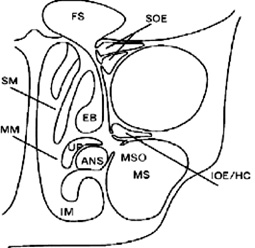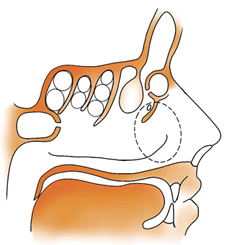
The "silver" people among us! Who are they?
The professor Yuri P.Uliyanov has established that
every third among us is a "silver".
Constitution of the silver people is programmed to use silver in immunity,
protective and vital processes, therefore they require ions of silver,
for example, in silver water - sacred water, silver utensils and silver
ornaments.
The alternative medicines for silver do not exist, therefore for silver
already
today traditional ways of medicimal therapy require reconsideration.
 Seasonal rhinitis and silver drops for a nose
Seasonal rhinitis and silver drops for a nose
Acut rhinitis and "Silver People" among us.
Peculiarities of the therapy of the chronic ethmoiditis when treating "Silver People".
Peculiarities of the therapy of the chronic ethmoiditis when treating "Silver People".Ulyanov Y.P. The XYII World Congr. of Otorhinolaringology. (IFOS,Sept.28-Oct.3,2002,Cairo, Egypt.) |
ABSTRACT:New data about the successful application of colloidal silver during the process of carrying out therapy for acute rhinitis in "silver people" (Y. P. Uliyanov 1998-2000) allow us to use this effect for treating chronic purulent ethmoiditis (CPE) of the same patient population. It is possible to assign the patients to the group of "silver people" using the author's method of positive response of the nasal mucosae to colloidal silver (5% sol. Collargoli). In the course of examination of 300 such patients with chronic rhinitis, chronic sinusitis was found in 172 patients, from who the CPE was detected at 95 patients. We used 5% sol. Collargoli in the form of drops into the nose 6-8 times per day to treat patients with CPE. At the same time, general antibacterial therapy was carried out. In 77 cases, the recuperation occurred in 3-4 weeks; other patients showed considerable improvement and needed an additional local surgical drainage of the blocked cells of the ethmoid labyrinth (EL). Thus, the colloidal silver eliminates inflammatory rhinedema of "silver people" so effectively that its use in treating chronic sinusitis facilitates the cure of CPE in most of these patients as well.Introduction:"For a number of years, the incidence of chronic rhinitis and sinusitis has continued to grow, and this tendency is expected to continue for the next years, in spite of modern achievements of medicinal therapy and endonasal microsurgery"[1,2]. This phenomenon is being explained by the growing deterioration of the ecology, which is well founded, as well as reduced resistance of the cellular system of the nasal cavities to repeated and chronic inflammation processes. This development is the most noticeably reflected in the topographic-anatomic and physiological features of the ethmoid labyrinth, which plays a leading role in formation of chronic sinusitis [3,4]. The narrow ostia of the cellular system of the ethmoid labyrinth provide sufficient drainage of the cells only when they are healthy. However, in the event of acute inflammation of the mucous membrane of the nose, the inflammatory process is likely to become a chronic process in a vicious circle. This is explained by the sharp reduction of the clearance for the ostia of the cells, due to the inflammatory edema of the mucous membrane, which complicates introduction of medications into the cells and leads to a retention of secretions in the cells and is accompanied by an elevation of the pressure in them. And this, in turn, leads to additional activation of the inflammatory process in the closed cellular system with an increase in both the quantity of secretions and the inflammatory edema toward the area of the ostium of the cells, to the point of complete blocking of the inflamed mucous membrane. The inflammatory products accumulating at the site (proteins, lipids, and cell remnants) also condition an inflammatory reaction, development of edema of the mucus membrane, proliferation of fibroblasts, and the simultaneous process of fibrosis leads to irreversible changes in the edematic mucosa in the area of the ostia of the cellular system of the ethmoid labyrinth. Such a closed circle of inflammation easily becomes a chronic condition, and it cannot resolve independently. This was typical for "sauterne" type of nasal aerodynamics, when instead of good ventilation of the ethmoid labyrinth in the "northern" type, when the ethmoid labyrinth was ventilated very actively, the mine air stream upon inspiration passed through the inferior meatus that led to stagnation into the cells of the ethmoid due to the hypoventilathion Only endonasal microsurgery provides a way to drain these impacted cells of the ethmoid labyrinth [5,6,7]. At the same time, the search for new more effective methods of conservative treatment for chronic ethmoiditis is continuing because they are maximally sparing and remains as fundamental for treatment of children. [3]. New information about expressed anti-inflammation efficacy of a preparation of silver (sol. Collargoli 5%) in treatment of acute rhinitis in a separate group of patients called "silver people" has turned out to be useful (Russian Patent N 95112165)[8]. During testing in Russia of 1000 patients with rhinitis and rhinosinusitis, the "silver people" were identified at a rate of 37%. Usage only sol. Collargoli 5% in the form of drops in the nose removed the edema of the mucus membranes and facilitated the rapid reversal of the manifestations of acute rhinitis or exacerbation of chronic rhinitis in these patients (in 2-3 days) [9]..Patients and Methods:For exposition of the possibilities of use of sol. Collargoli 5% during treatment of chronic sinusitis (ethmoiditis), we conducted further study of this group of patients. Three hundred patients (ages from 2 to 78, the majority of whom were male) were under our observation, having presented in the fall-winter season in connection with acute rhinitis or exacerbation of chronic rhinitis. All these patients belonged to the group of "silver people," according to the results of a positive response of the mucus membrane to introducing drops of sol. Collargoli 5% into the nose. This was expressed by a reduction in the edema of the mucus membrane of the nose, including the lower nasal turbinate, cessation of the secretions from the nose (it became dry in the nasal passages) and reduction of the signs of irritation of the mucus surface. Nasal breathing became freer, the feelings of stuffiness in the nose and heaviness in the head were reduced. Treatment was carried out with introduction 5-6 times of sol. Collargoli 5% into the nose and general anti-inflammatory treatment, which permitted elimination of the manifestation of acute rhinitis and exacerbation of chronic rhinitis in 2-3 days. The acute rhinitis was difficult to distinguish from exacerbation of the chronic condition, since only after elimination of the acute manifestations of inflammation was the subatrophic rhinitis discovered with disturbance of nasal aerodynamics of the "southern" type, when the main flow of air at the inspiration enters through the inferior meatus, causing its overload with subsequent development of acute inflammation in the form of exacerbation of the chronic rhinitis. These violations of aerodynamics of the nose, as we already know, facilitate development of stagnant processes in the sinuses of the nose (ethmoid labyrinth) with development of ethmoiditis due to insufficient ventilation of the middle nasal passageway. Among the group of patients with chronic rhinitis in 252 ( 84%), chronic ethmoiditis was found in 172 patients with purulent inflammation in the ethmoid labyrinth in 95 (from age 8 to 62, more men than women). Having received positive results from treatment of chronic rhinitis and manifestations of exacerbation of the chronic variety with sol. Collargoli 5%, we decided to continue such treatment in persons with chronic ethmoiditis (confirmed by CT scan). Particular attention was paid to the method of introduction of drops into the nose,
Results:During conducting of treatment, already the first two weeks, it was possible to observe significant improvement with cessation of active purulent secretion from the nose and improvement of nasal breathing. Treatment with antibiotics ended a week after disappearance of the purulent secretion in the nose, but the general and local anti-inflammatory treatment continued two more weeks (the cyclic timeframe for the inflammatory process). The results of the treatment were positive in 77 cases (from 95) after 3-4 weeks when it was possible to conduct a full course of treatment (in 6 cases, treatment was interrupted for external reasons). In 12 cases, additional endosurgical drainage of blocked cells of the ethmoid labyrinth was needed and has been performed with good results too.Discussion:During analysis of the results received of the trial and treatment of chronic ethmoiditis in "silver people," a number of features become apparent, both the clinical manifestations of this condition and factors of the efficacy of the treatment conducted with use of silver-containing drops (sol. Collargoli 5%). First of all, attention should be paid to the absence in "silver people" of the polypous process in the cells of the ethmoid labyrinth. Only in three cases were there manifestations of hypertrophy of the lower turbinates with reappearance signs of the polypous process. And second, absences of vasomotor disturbances (oedemas) of the nasal mucosae. Therefore, the edema of the nasal mucosa in the area of the ostium of the ethmoid cells could be only an inflammatory development. And this confirms the results of treatment use of sol. Collargoli 5%, which quickly and effectively removes the inflammatory process and inflammatory edema of the nasal mucosas, as well as effectively opens the ostium of the cellular system of the ethmoid labyrinth. Such rapid and effective curing of chronic ethmoiditis, even with purulent inflammatory process can be explained only by the mechanism of effective drainage of the cells of the ethmoid labyrinth. Also, should be in view, that one of the programmed reasons of development of chronic ethmoiditis could be the southern type of nasal aerodynamics and so, the last is needed in additional reconstruction into the "northern" one.Conclusions:1. Chronic ethmoiditis in "silver people" advances without the polypous process and without vasomotor disturbances of nasal mucosa, therefore, the edema of mucosa in the area of the ostium of the ethmoid cellular system bears a purely inflammatory character. 2. Use of sol. Collargoli 5% during treatment of chronic ethmoiditis in "silver people" is justified and highly effective, since it allows the realistic possibility of eliminating the inflammatory edema of the mucosa of the ostium of the ethmoid cells, that restores their drainage without surgical intervention. 3. During treatment of chronic purulent ethmoiditis in "silver people," use of silver-containing drops should be recommended for the nose (sol. Collargoli 5%) with simultaneous general antibacterial (antibiotic) therapy. 4. The "southern" type of nasal aerodynamics could be one of the programmed cause of development of chronic ethmoiditis and so, such nasal aerodynamics is needed in additional reconstruction into the "northern" one. References:[1] Palchun V.T., Ustyanov Y.A., Dmitryev N.D. Paranasal sinusitides, ?oscow: 1982, 150. (in Russian) [2] Piskunov S. Z., Piskunov G. Z., About physiological role of nasal sinuses. Russian Rhinology. 1997;(1):16-7. (in Russian) [3] Borzov E. V., Sakharov V. I. Nasal sinusitises for children. Russian Rhinology.1997;(2):18. (in Russian) [4] Piskunov S. Z., Razinkov S. P., Dolzhikova N. V., Tarasov I. V., Korshikov V. N., Elkov I. V. Complex function endoscopically surgery of nose and nasal sinuses. Russian Rhinology.1998;(2):62-3. (in Russian) [5] Mandy S.H. A new primary wound dressing made of polyethylene oxide gel. Dermatol.Surg.Oncol.1983; 9:153-5. [6] Grinnell F. Fibroblasts, myofibroblasts, and wound contraction. Cell, Biol. 1994;124:401-4. [7] Piskunov C. Z., Some anatomic-physiological problems of function rhino-sinus-surgeries. The Russian Rhinology. 1998;(2):62. (in Russian) [8] UliyanovY.P, Acute rhinitis and drugs of silver. J.Vrach. 1998; (4):40. (in Russian) [9] UliyanovY.P. Acute rhinitis and silver people among us. Abstract of the report in MidWinter Meeting of ARO. 2000. http://www.aro.org/ http://www.airsilver.net/ch32.html |